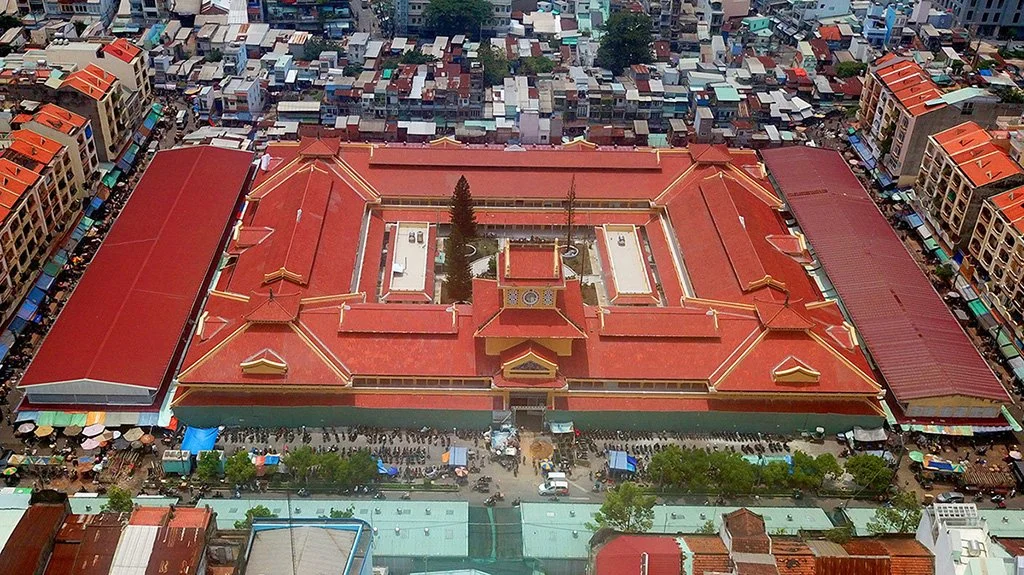The Chinese Community in Saigon: A Tapestry of History, Culture, and Influences
Bert Nguyen
Associate Language Manager and Copywriter at Flynde
Ho Chi Minh City, casually known as Saigon, may remind many tourists of its bustling traffic and LED-lit skyscrapers. However, their experiences of the city remain incomplete without a visit to Chợ Lớn – the city's historic Chinatown. The presence of the Chinese community here dates back centuries and has played a crucial role in shaping the city’s cultural landscape.
A Bit of History
Chinese migration to Vietnam began as early as the 17th century, with people from the Ming Dynasty fleeing political turmoil in China. In an act of compassion, local lords granted these immigrants the right to settle in newly broken lands in southern Vietnam. New townships gradually emerged and thrived, one of which would later become Chợ Lớn. Over time, more Chinese immigrants arrived, drawn by trade opportunities and the region's growing commerce.
(A religious ceremony in a Chinese temple in Cho Lon around 1866.
Source: Emile Gsell / Wikimedia Commons)
By the 19th century, under French rule, Cho Lon had strongly developed into a commercial centre with many shophouses, restaurants, and banks. These Chinese establishments and their trades benefit not just their own community but the city as well. The Chinese-Vietnamese, better known as the Hoa people, formed tight-knit communities based on their place of origin in China. Today, they make up the Five Clans of Cho Lon, namely Guangdong, Fujian, Teochew, Hainan, and Hakka.
Languages and Traditions
One of the defining features of the Chinese community in Saigon is its linguistic diversity. While Vietnamese remains the primary language in the city, Chinese dialects lead a strong and vivid life on the streets of Cho Lon. It’s not surprising if you hear some aunties and uncles at a random store or temple there conversing in Teochew, Hakka, Hokkien, or most noticeably, Cantonese. Also, Mandarin and Cantonese can be heard on special news programmes on the city's official radio channel. These dialects go beyond the purpose of communication. They carry cultural heritage, storytelling, and community bonds across generations in Cho Lon.
Apart from languages, the Chinese community is known for maintaining unique traditional festivals, such as the Tet Nguyen Tieu (Lantern Festival) and Le via Quan Cong (Guan Yu Spirit Festival). During these events, streets are adorned with red lanterns, lion dances are performed, and offerings are made in temples, reflecting Chinese customs passed down through the ages. The blend of Vietnamese and Chinese customs during these festivities illustrates the deep cultural intermingling between the two communities.
Influences on Vietnamese Culture
The Chinese community's influence on Vietnamese culture is most apparent in southern Vietnam. In terms of cuisine, Chinese dishes have become staples in Saigon's food culture. Dim sum, wonton noodles, and the ever-popular banh bao (steamed buns) are all examples of Chinese culinary contributions cleverly adapted to suit local tastes. Every weekend, Cho Lon food streets are usually crowded by people yearning for a unique fusion of Chinese and Vietnamese flavours.
Binh Tay Market - the most important market in Cho Lon
Source: Phap Luat
Additionally, Cho Lon is also known as a big trading hub for centuries with heaps of banks, stores, and companies. The name Cho Lon itself translates to “Big Market.” The most iconic building in this place is Cho Binh Tay, which is, as you may have guessed, a huge market. Many big brands in Vietnam were founded by Vietnamese of Chinese origin.
Additionally, Chinese religious practices, such as worship in Taoist and Buddhist temples, have had a significant impact on Vietnamese spiritual life. Temples like Chùa Bà Thiên Hậu, dedicated to the Patron of Seafarers, attract both Chinese and other Vietnamese worshippers, showcasing the shared religious practices that bridge the different ethnic communities.
The Chinese community in Saigon has profoundly shaped the city's cultural and economic landscape since their arrival in the 17th century. Their linguistic diversity, traditions, and contributions highlight the enduring bond between the Chinese and the Vietnamese, an ever-vibrant connection in Ho Chi Minh City today.
COFFEE WITH BERT
This is to bring you the richness of global traditions straight to your desktop.
Join Bert Nguyen - one of our copywriters, as we journey beyond borders—celebrating diversity, bridging cultures, and uncovering the stories, places, and people that make our world so fascinating.



